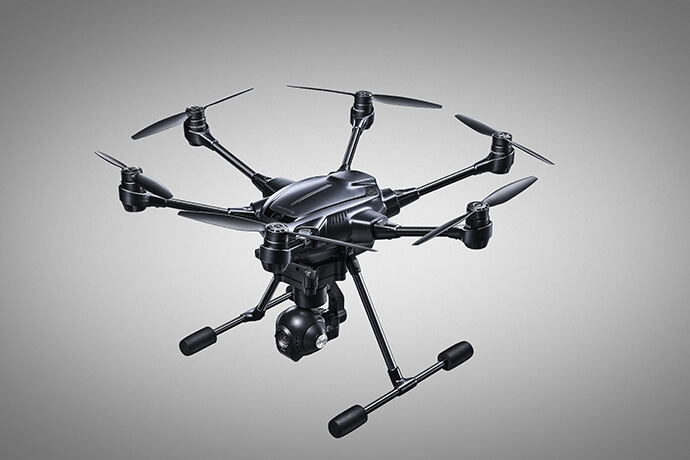VB: There’s another idea for flying billboards that might come to pass.
Nanduri: Right. The light show leads to ideas like ads in the sky, logos in the sky. We’ve already shown it. We’re pretty amazed at the reactions. There may be a business in that. It’s pretty interesting to see how people want to apply this in ways that even we couldn’t think of.
VB: What’s your road map for what lies ahead, all the things you have to get done?
Nanduri: We have a couple of products, a fixed wing product and a multi-rotor, the latter of which is the first Intel-branded drone for commercial use cases. We call it the Intel Falcon 8+. They both have yet to come into the U.S. market. That’s our immediate focus. We already announced them, and we’re looking forward to the last part of the execution, rolling them out.
We also have the flight planning algorithms and software, automatic tools for seamless integration of flight planning capabilities. We have some of that technology from our fixed wing, and we’re bringing it down to all of our product road map. Having more automation in the workflow is somewhere we’ll continue to push the envelope.
We’re building more safety features with RealSense. What we brought in with Yuneec, we want to integrate that into the commercial systems as well. You can think of a couple of use cases. Say you want a drone to fly within three meters of the inspection area and hold that position, or you want to fly into GPS-denied environments. If you fly under a bridge and the signal isn’t strong, how do you make sure that stays seamless? These are the kinds of capabilities that enhance the robustness of the UAV itself.
The light shows, we’ve operationalized that and they’re getting better. We’re deploying them at scale. Then we’ll take that same fleet management technology and apply it to the commercial side as the regulations continue to open up. We had to get a waiver from FAA to do the light shows. Using that information, we’ll continue to work with regulators on how that can become a mainstay in the future.

Above: Intel is diving deep into drones.
VB: How do you think you’ll generally proceed with getting people comfortable around the idea of drones? They have this ability to go anywhere, to take pictures, to record.
Nanduri: In terms of the consumer side, there’s a lot of uptake. You go to the park and see more and more drones flying. Now, any technology, there’s always a perception issue. You think back to when cell phones first had cameras on them. We went through the same learning curve. How do you address privacy? There are already frameworks for handling these issues. I don’t think drones by themselves form a new issue. It’s an extension of what’s already been addressed. In a decade from now, I think, people will look back and say, “Wow, I didn’t realize people even wondered about this.” But public perception is always a journey.
We’ve asked ourselves how to get drones into the public’s perception. The light shows have been a phenomenal way of bringing that in front of people. They start to understand drones. They say, “Wow, I never realized we could use them this way.” People become more familiar. That’s one mechanic for bringing it to an audience, and we want to continue to use that channel. We want to spread that experience as widely as possible. It’s a great way to tell the drone story.
The other part is safety features, making sure the public understands that these are pretty safe if you get the right designs and the right attributes in. The light show drones we built are only 280 grams each. It’s less than the weight of a volleyball. I have pictures where I’m trying to catch it in my hand. Hopefully, we’ll be able to expand that conversation.
VB: Where do you see the technology evolving, and at what rate? It seems like, with a 15-minute battery life on most drones, we’re at the stage where cell phones were at one point.
Nanduri: You’re right. There’s also innovation in spaces like hybrids. Is that the right answer? How do you extend the technology we have today? You look at electric cars — we started with 40-mile ranges and now we see cars with 250 miles. The battery technology hasn’t fundamentally changed. It’s how you apply and deploy it. I definitely see innovation coming.
We do have to live with some constraints. I wish battery technology advanced like Moore’s Law does. But innovation still happens in how you work around those challenges. A year back, if you told somebody you saw a day where you’d have 100 drones flying together with a single pilot, they wouldn’t believe you. Now we’re already at 500.
This is what keeps me excited. You can see where drones can be applied — first response, search and rescue, construction, infrastructure. Drone racing might become a popular entertainment. There are all the consumer use cases. It’s a personal flying camera. If people think of drones as a camera, it changes the conversation in terms of the consumer thought process. People carry around selfie sticks now. You could do the same thing with a drone hovering above you.
The technology is going to make all this happen. That’s my firm belief. In a decade from now, you’ll see wide acceptance of this technology.
VentureBeat's mission is to be a digital town square for technical decision-makers to gain knowledge about transformative enterprise technology and transact. Learn More

